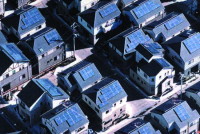Developing Power Cell Technology Provides Options When the Lights Go Out

As Governor Cuomo’s Moreland Commission continues to gather information about the operations of major utility companies in the wake of super storms that have left large areas of New York without electricity for long time periods, some small companies with innovative ideas are trying to attract attention.
One such company is Arista Power, a Rochester, New York-based technology firm with a proprietary battery storage and power management system that offers a new approach to powering up when the grid is down.
Founded in 2009, the company had its beginnings in a garage where the inventor tinkered with small wind turbine engines. By 2010 the company had its first military contract.
In an interview, Cherrie Mahon, VP of Investor Relations and Corporate Communications, explained the company does not have to do any cold calling. “People are finding us by word of mouth and through the Internet,” she said. “We’ve been testing our market over the past two years by providing systems to the military. They demanded a reduction in reliance on fossil fuels and needed to get power to remote locations. They did not want to use costly diesel fuel generators that created unhealthy fumes and a lot of noise.”
For the military Arista built micro grids powered by solar and wind energy that can be carried by helicopter and easily dropped where they are needed. “With the occurrence of Hurricane Sandy, the demand for these micro grids became urgent,” Mahon explained. “When there is an emergency the cost of diesel shoots up and transporting it becomes a problem. We often don’t realize we have a problem until there is a disaster, so Sandy created an unfortunate opportunity to seek other solutions.
Mahon said New York City has been looking at the possibility of purchasing the mini power stations, which also go into operation when a power surge puts too much stress on the national grid system.”
The technology behind the success of the micro grids is the lithium ion battery manufactured by General Electric. As battery storage technology has been improving, the costs of manufacture have been coming down. In combination with renewable energy sources such as wind and solar, systems from the smallest residential need to industrial complexes can be supplied with power that is both stored and managed.
While the company had its birth in the wind turbine business, Mahon explained that wind technology does not work in most areas of New York State but the solar systems have been very successful. “Solar system pricing and efficiencies are getting better over time,” Mahon said.
The Arista’s Power on Demand system stores the energy captured from photovoltaic solar cells along with off peak grid power, and then releases the power during peak demand hours. This results in lower demand charges and utility bills for the customer.
As part of an innovative program in Genesee County, Arista Power is the lead contractor working with NYSERDA for a solar purchasing program for their community, called “Solarize Hornell.” The program includes a streamlined process from site assessment to installation and tax incentive form assistance, educational workshops, and local workforce training. The program will be available to area home and business owners, farmers, institutions, and municipalities on a first come, first serve basis for a limited time. Site assessments are complimentary.
Dependent upon site location, energy consumption, and utility charges, Arista power calculated a sample solar system cost/return on investment scenario for White Plains/Westchester County using the company’s products and systems.
In 2012, the average residential install charge for solar in Westchester County was $5.36/Watt. If the community were to support a solarize program in the area, the company claims pricing discounts of 15 to 20 percent could be realized.
A community program that uses the community’s total solar purchases for bulk pricing (cost efficiencies), streamlined quoting and complimentary site analysis, and educational workshops on solar (and if the total community purchase reaches 100 kW in total volume of orders), the pricing for installed solar will be $4.50/Watt, with 3 kW the minimum size. Additional pricing discounts would occur if total install orders were above 100 kW.
For a 5 kW sized Solar System, at $0.20/kWh charge from the utility, the system will produce on average 6300 kWh/year depending on site location. The total cost of $22,500 is calculated at 5kW x $4.50 charge for community bulk purchase as part of the solarize program.
With a NYSERDA incentive of 5kW x $1.50 equal to $7,500 there is an initial out of pocket of $15,000. With 30 percent federal tax credit for qualified at $4,500 and 25 percent NYS tax credit for qualified at $3,750, the out of pocket cost is $6,750.
At $0.20/kwh charge from utility, this system will produce approximately 6300 kWh/year, therefore, a household using 7000 kwh a year can expect a payback on this size system in 4.9 years, depending on the utility charge.
For more information about Arista Power visit AristaPower.com.
